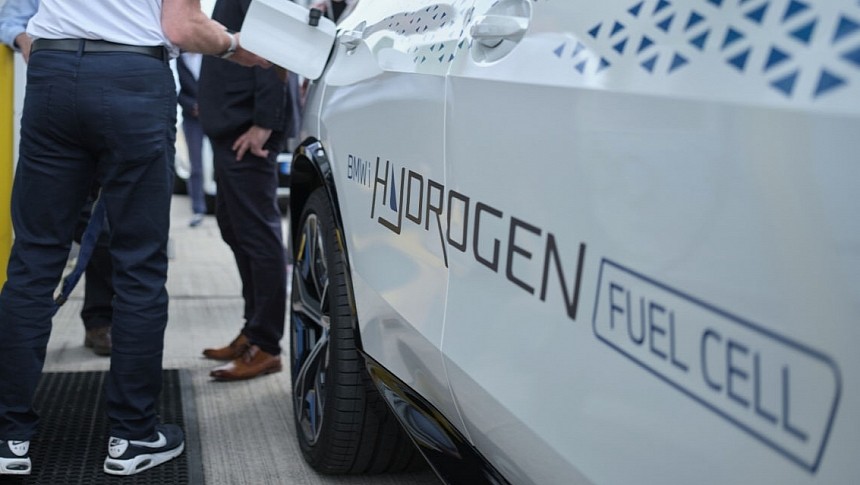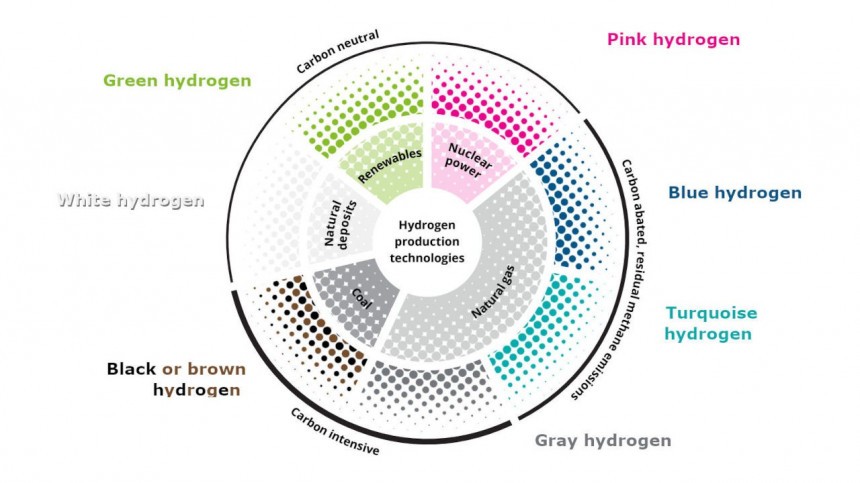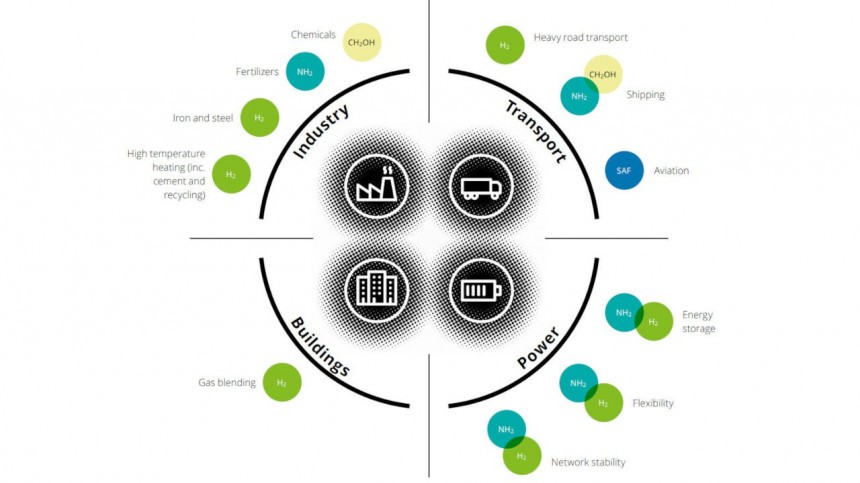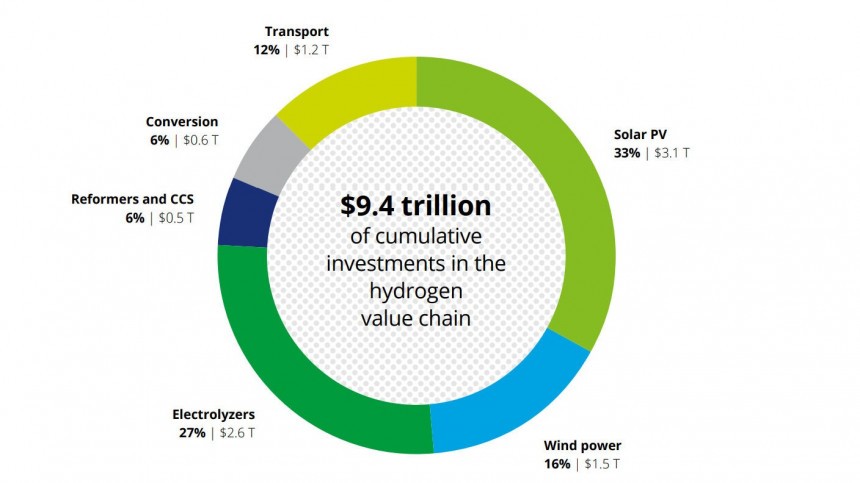There's an ongoing battle out there between the battery electric vehicle proponents and fuel-cell hydrogen ones. For the regular driver who is used to the comfortable range and short and convenient refueling time, the H2 is the ideal alternative to gasoline or diesel internal combustion engines. Oil & gas companies are also favoring the hydrogen solution because it seems to mirror their business model.
The problem is that EVs evolve at a faster pace than anyone expected while hydrogen technology lags. I know that's a controversial statement, but hydrogen and cars are still not the love story Toyota bet on big time several years ago. Let's see if BMW will wow the car industry with its pilot fleet of less than 100 iX5 Hydrogen, which was deployed for trial purposes at the end of June.
The chances for that to happen are slim, as a recent report from the well-known Deloitte, one of the leading consultancy companies in the world, gives us a glimpse of the main purposes of hydrogen in the future so-called "clean hydrogen market."
There are several technologies for producing H2. Some of them are carbon-intensive, while some of them are clean, more or less. The industry is using a color code to differentiate them, and Deloitte has a nice diagram for everybody to understand the situation.
Carbon neutral technologies:
Carbon abated, residual methane emissions technologies:
Carbon-intensive technologies:
Now that we have an idea about how clean hydrogen could be sourced, it's time to acknowledge that almost the entire hydrogen industrial production currently relies on carbon-intensive technologies like coal gasification and natural gas reforming.
So, unfortunately, the pilot fleet of the BMW iX5 Hydrogen and all the other hydrogen cars in use today can be blamed for related pollution, even if they don't pollute when in use. Hilarious or not, it's the same accusation used by EVs detractors regarding battery electric cars… But for now, let's get back to Deloitte's meaning of "clean hydrogen".
Deloitte's calculation shows that in 2050 the industry should produce at least 600 MtH2eq (million tons of equivalent H2). To put things in perspective, the effect could be an abatement of around 85 GtCO2eq (giga tons of CO2 equivalent), a value of more than double CO2 emissions in 2021. But only if clean hydrogen will replace fossil fuels industrial use and carbon-intensive technologies for sourcing hydrogen.
By the way, there's been a lot of debate about hydrogen use in the car industry, but Deloitte's report could prove many people wrong. Actually, hydrogen is much more important for other industries and fields, and in a climate-neutral energy system, the main end uses would be those in the following diagram.
Deloitte forecasts that in 2050 industry will account for 42% of total clean hydrogen demand, followed by transport with 36%. The rest will mainly go into power generation and a small amount into buildings heating.
Now here's the thing: transport needs are going to be stringent. As heavy-duty freight, aviation, and shipping will be hard, if not impossible, to electrify at a large scale, they are expected to consume most of the hydrogen produced for the transport sector.
This means the car industry will have to rely mainly on electrification – and I think the race for battery factories and the flock of new electric models is self-explanatory in that regard. So, don't expect that fleet of BMW iX5 Hydrogen to grow any time soon.
There is another strong reason: based on the list of clean hydrogen projects announced worldwide, Deloitte suggests that in 2030 their collective production capacity will account for only 44 MtH2eq, roughly one-quarter of the projected demand of 170 MtH2q at the end of this decade. Simply put, there's a high chance that clean hydrogen will not meet demand.
This may surprise many, but you should know that, in 2022, world investments in fossil fuel production facilities were around $417 billion. It's outrageous if you think that in July 2023, the average global temperature hit a new record. Unfortunately, Big Oil doesn't seem to care about rampant global warming as long their business is so profitable.
By comparison, Deloitte estimates that global investments for clean hydrogen production should reach at least $9.4 trillion. That is $9,400 billion, or 22 times more than yearly investments into oil & gas production! That's a tough choice for policymakers, politicians, and investors, especially in a very sensitive environment because of post-pandemic, geo-political, and all sorts of economic issues.
How about the fierce competition for clean energy? Deloitte predicts that half of the investments for clean hydrogen will go into solar and wind capacities. This raises some questions about efficiency because $4.5 trillion in investments in solar and wind could be of much more use for the power and energy sector.
Remember that today the industry sector uses vast amounts of carbon-intensive grey hydrogen – almost 100 MtH2eq a year. It is much needed in the chemical industry to produce ammonia for fertilizers, which are of critical importance for crops and avoiding a global hunger crisis. The iron and steel sector is another crucial "client" for hydrogen; other fields in the industry and energy storage are expected to be prioritized against transport.
Remember that directing green technologies investments, like solar and wind, into hydrogen production could prove worse than using those for the power sector (and consequently electric vehicles). And for sure, we can all agree that hydrogen should serve heavy transport in the first place, not personal transportation.
Last time I checked, Deloitte wasn't a clairvoyant type of company. Its report is based on solid data and information. The forecasts depend on whether or not analysts' recommendations will be implemented. For now, there are fifty-fifty chances for the clean hydrogen economy to become a reality following these predictions.
As for the fuel cell hydrogen cars, such as Toyota Mirai or the BMW iX5 Hydrogen, I simply don't think there's a brilliant future. Facing Deloitte's predictions, I myself predict hydrogen cars' share will be insignificant. The demand for clean hydrogen will simply be too high in other, more important fields.
The chances for that to happen are slim, as a recent report from the well-known Deloitte, one of the leading consultancy companies in the world, gives us a glimpse of the main purposes of hydrogen in the future so-called "clean hydrogen market."
"Clean" doesn't necessarily mean what you think
You're right if you think that burning hydrogen is a clean process. In a fuel cell stack, the hydrogen reacts with the oxygen in the air resulting in water and electricity. However, just like people point out that battery production is polluting, we have to wonder where the hydrogen in a BMW iX5 Hydrogen comes from.There are several technologies for producing H2. Some of them are carbon-intensive, while some of them are clean, more or less. The industry is using a color code to differentiate them, and Deloitte has a nice diagram for everybody to understand the situation.
- Green hydrogen is produced from electrolysis using renewable electricity, mainly from solar and wind, so it's the least carbon-intensive technology and releases no direct emissions
- White hydrogen refers to natural stockpiles of hydrogen, which can be extracted from drilling in underground wells
- Pink hydrogen is produced via the electrolysis of water using nuclear power, so it's a carbon-neutral process.
Carbon abated, residual methane emissions technologies:
- Blue hydrogen complements grey hydrogen with carbon capture and storage (CCS) technology. However, this technology will hardly achieve carbon neutrality in the long run due to residual emissions and upstream methane emissions
- Turquoise hydrogen can be produced via pyrolysis of natural gas, and direct carbon emissions are avoided. It's a much more expensive technology than alternatives and must deal with upstream methane emissions.
Carbon-intensive technologies:
- Grey hydrogen relies on natural gas reforming (via steam methane reformation, auto-thermal reformation of methane, or methane gas-heated reforming), the most widely adopted technology today. Carbon emissions associated with SMR (9kgCO2/kgH2) and upstream methane emissions resulting from natural gas supply make grey hydrogen an emission-intensive process
- Black or brown hydrogen refers to the gasification of coal, the most polluting technology, with 20 kgCO2/kgH2 of emissions released during the process.
Now that we have an idea about how clean hydrogen could be sourced, it's time to acknowledge that almost the entire hydrogen industrial production currently relies on carbon-intensive technologies like coal gasification and natural gas reforming.
So, unfortunately, the pilot fleet of the BMW iX5 Hydrogen and all the other hydrogen cars in use today can be blamed for related pollution, even if they don't pollute when in use. Hilarious or not, it's the same accusation used by EVs detractors regarding battery electric cars… But for now, let's get back to Deloitte's meaning of "clean hydrogen".
Green and blue hydrogen could be the future
In the latest report, "Green hydrogen: Energizing the path to net zero. Deloitte's 2023 global green hydrogen outlook", analysts concluded that green hydrogen and blue hydrogen are the best technologies the industry should prioritize to achieve climate neutrality by 2050. Therefore, green and blue hydrogen are considered the perfect mix for the so-called clean hydrogen.Deloitte's calculation shows that in 2050 the industry should produce at least 600 MtH2eq (million tons of equivalent H2). To put things in perspective, the effect could be an abatement of around 85 GtCO2eq (giga tons of CO2 equivalent), a value of more than double CO2 emissions in 2021. But only if clean hydrogen will replace fossil fuels industrial use and carbon-intensive technologies for sourcing hydrogen.
By the way, there's been a lot of debate about hydrogen use in the car industry, but Deloitte's report could prove many people wrong. Actually, hydrogen is much more important for other industries and fields, and in a climate-neutral energy system, the main end uses would be those in the following diagram.
Now here's the thing: transport needs are going to be stringent. As heavy-duty freight, aviation, and shipping will be hard, if not impossible, to electrify at a large scale, they are expected to consume most of the hydrogen produced for the transport sector.
This means the car industry will have to rely mainly on electrification – and I think the race for battery factories and the flock of new electric models is self-explanatory in that regard. So, don't expect that fleet of BMW iX5 Hydrogen to grow any time soon.
There is another strong reason: based on the list of clean hydrogen projects announced worldwide, Deloitte suggests that in 2030 their collective production capacity will account for only 44 MtH2eq, roughly one-quarter of the projected demand of 170 MtH2q at the end of this decade. Simply put, there's a high chance that clean hydrogen will not meet demand.
Clean hydrogen is hugely expensive
Because the fossil fuel industry's massive carbon footprint is not properly taken into account, and the prices don't include the environmental externalities, oil & gas remain very affordable compared to clean hydrogen technologies.This may surprise many, but you should know that, in 2022, world investments in fossil fuel production facilities were around $417 billion. It's outrageous if you think that in July 2023, the average global temperature hit a new record. Unfortunately, Big Oil doesn't seem to care about rampant global warming as long their business is so profitable.
By comparison, Deloitte estimates that global investments for clean hydrogen production should reach at least $9.4 trillion. That is $9,400 billion, or 22 times more than yearly investments into oil & gas production! That's a tough choice for policymakers, politicians, and investors, especially in a very sensitive environment because of post-pandemic, geo-political, and all sorts of economic issues.
Remember that today the industry sector uses vast amounts of carbon-intensive grey hydrogen – almost 100 MtH2eq a year. It is much needed in the chemical industry to produce ammonia for fertilizers, which are of critical importance for crops and avoiding a global hunger crisis. The iron and steel sector is another crucial "client" for hydrogen; other fields in the industry and energy storage are expected to be prioritized against transport.
The odds are not in favor of hydrogen cars
As you can see, there are a number of issues. Firstly, clean hydrogen requires huge investments, and this implies prioritizing the most important industries – the car industry is definitely not among the priorities. Secondly, if policymakers can't agree faster on the best (and most likely unpopular) decisions for a hydrogen economy framework, there's a high risk of hydrogen scarcity.Remember that directing green technologies investments, like solar and wind, into hydrogen production could prove worse than using those for the power sector (and consequently electric vehicles). And for sure, we can all agree that hydrogen should serve heavy transport in the first place, not personal transportation.
Last time I checked, Deloitte wasn't a clairvoyant type of company. Its report is based on solid data and information. The forecasts depend on whether or not analysts' recommendations will be implemented. For now, there are fifty-fifty chances for the clean hydrogen economy to become a reality following these predictions.
As for the fuel cell hydrogen cars, such as Toyota Mirai or the BMW iX5 Hydrogen, I simply don't think there's a brilliant future. Facing Deloitte's predictions, I myself predict hydrogen cars' share will be insignificant. The demand for clean hydrogen will simply be too high in other, more important fields.









